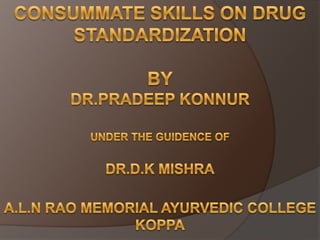Consummate skills on drug standardization
- 2. INTRODUCTION ď‚ž The ayurvedic practice of drug formulation and drug adminstration are based on clearly defined and formally standardised principle and practices. ď‚ž At the same time they allow subjective modification and adptation to a great extent . ď‚ž This give rise to development of different regional traditions. Each traditions has its own unique standards.
- 3. STANDARDIZATION: ď‚ž The word verbally means degree of excellence. ď‚ž The word standardization implies the application of suitable methods and process by which optimum conditions are ensured for obtaining predictable results and products, which confirm certain sets of standard in quality, purity, safety and shelf life etc.
- 4. NEED FOR STANDARDIZATION ď‚ž To safe guard and strengthen the interest of the manufacturers of ethical Ayurvedic products, the physicians and the consumers with quantitatively best Ayurvedic medicines. ď‚ž Now a days people are not ready to believe the older truth as it is, but they will accept the same older truth in the focus of new scientific cameras analytical approach.
- 5. TRADITIONAL METHODS OF STANDARDIZATION: They are largely organoleptic . The quality parameter are measured by the 5 sensory organs.  For ingredients The aroma of chandan. The color of rakta chandana.  For processes For avaleha processing – tantumat For kalaka of tailas for external use – khara paka
- 6. For kalaka of taila for nasya – mridu paka For kalaka of taila for internal use – chikkana paka Limit of boiling for tailas – frothing Limit of boiling for ghriths – subsiding off frothing. For products Smell and colour of tailas Taste of kashayas Rekhapurnathhwam for bhasmas.
- 7. MODERN METHODS OF STANDRADIZATION ď‚ž Standardization of crude drugs is needed for achieving genuine raw drugs, which affects the safety and purity and quality of the medicine. So to ensure the therapeutic excellence of Ayurvedic medicines, this must be the first step of standardization. ď‚ž It also include the shelf life, packaging and transport of raw drugs.
- 8. STANDARDIZATION OF CRUDE DRUGS ď‚ž Identification - Macroscopic and microscopic identification, fingerprint, chemical markers study by chromatography, spectrophotometer and x ray deflection. ď‚ž Collection - Places, season and mode of collection ď‚ž Drying - It includes two main principles temperature control, regulation of airflow ď‚ž Storage and preservation - There are important for maintaining the degree of quality of drugs.
- 9. STANDARDIZATION IN PHARMACEUTICALPROCESSES ď‚ž Regarding apparatus ď‚ž Regarding fuel ď‚ž Regarding duration ď‚ž Regarding procedure.
- 10. PARAMETERS FOR STANDERED FINISHED PRODUCTS Raw Material is to be standardized in QC laboratory Storage of the raw material under suitable conditions. Analysis of the Raw material at the time of Use. Manufacturing Process (The process also to be standardized) Standardization of the finished product in QC laboratory.
- 11. ď‚ž OFFICIAL STANDARDS FOR FINISHED PRODUCTS ď‚ž Physio chemical parameters for dasamoolarishtam. ď‚ž Total solids 25.0-30.0% ď‚ž Specific gravity 1.10-1.15 ď‚ž Reducing sugars 19.0-25.0% ď‚ž Non reducing sugars NMT 1% ď‚ž PH 3.50-6.00% ď‚ž Alcohol content 3.00-7.50%
- 12. HURDELS IN THE PATH OF STANDARDIZATION ď‚ž These standards are definitely a step forward from the traditional procedures. But they cannot be perceived as final, because there is definate scope for improvement.
- 13. SOLUTIONS FOR STANDARDIZATION ď‚ž There should be a uniform standard cultivation method for each and every drug to avoid variation in quality and chemical contaminations ď‚ž For standardization one has to conduct study to understand what chemical changes are happening after each process. Which can standardize one uniform level or range.
- 14. DISCUSSION ď‚ž It is better that one should establish the effect of medicine with clinical trials, not with chemical composition. ď‚ž Standardization is a need of this era but it should not be in such way, which is ultimately going to be harmful to ayurvedic physicians only.
- 15.  The whole exercises of standardization are not for understanding of ayurvedic principles but for logical conviction of the whole world. As the people believes in facts with figures.  Mother’s love to her child can’t be measures with help of kilograms, quintals etc. but it is present like wise ayurveda is also a science which cant be proved with help of modern methodology.
- 16. CONCLUSION Above suggested standardization procedures are time consuming but it is: ď‚ž Easy to follow ď‚ž Accurate ď‚ž Long lasting and rewarding. ď‚ž Causes minimal deviation from quality ď‚ž Applicable to all herbal formulations
- 17. THANK U

















